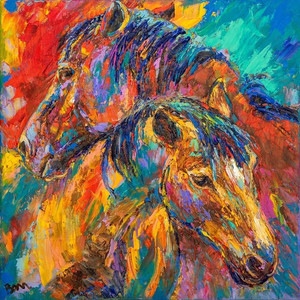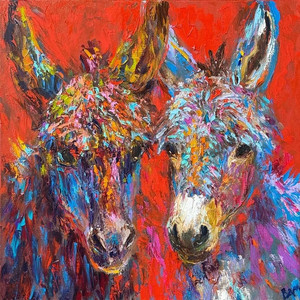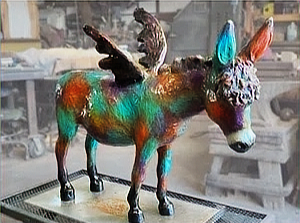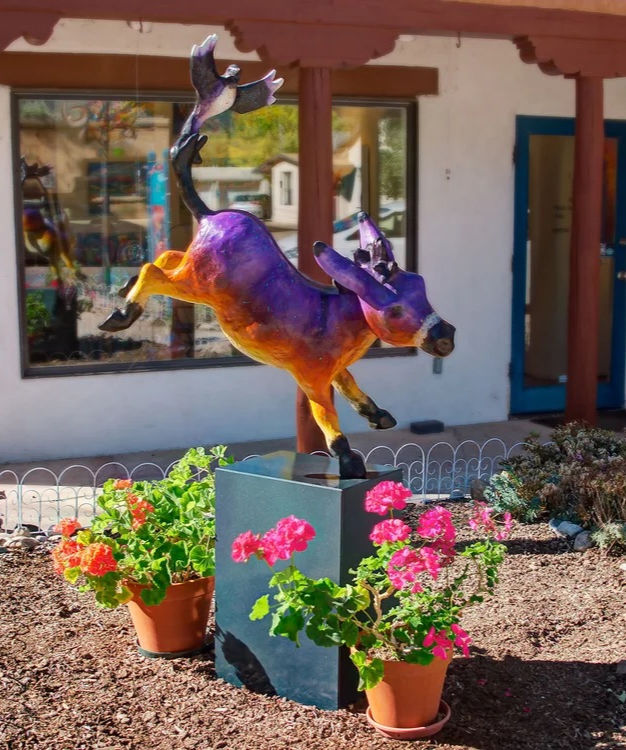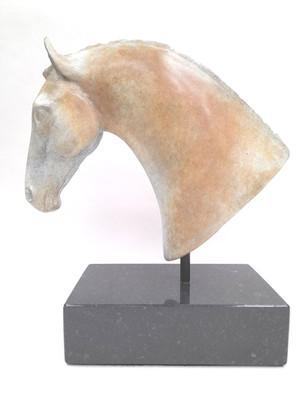- Robin Black

- Dec 11
- 6 min read
Updated: Dec 12
The Spark Behind Barbara's Journey
EquuStyle: How did you become interested in painting and sculpting donkeys?
Barbara Meikle: I was born a horse lover, learned all about the donkey when I had to caretake a pair of riding mules. Fell in love with their intelligence and personalities, visited a donkey rescue in Colorado, Longhopes, and was hooked! Wanted to paint them as much as I painted horses…

EquuStyle: Do you aim to portray the individual personality of each animal, or a more general 'essence' of a donkey?
Barbara Meikle: I actually try to do a little of both, there are individual traits like the length of coat, the dorsal stripe, etc., and then there is the gentle eye, the tilt of the ear when you’ve caught their attention that seems universal in the donkey world.
EquuStyle: How does your relationship with donkeys influence the way you portray them?
Barbara Meikle: I try to capture the physical differences between horses and donkeys because that is a distinction that is important to the physical presence of the horse vs the donkey—the angle of the head, the straightness of the back, smooth coat vs shaggy. My love for them lets me give them big brown eyes, a mischievous expression and the ability charm themselves out of trouble!
EquuStyle: What feeling or mood do you hope a viewer experiences when looking at your paintings and sculptures?
Barbara Meikle: Happiness! Joy, beauty, the chance to just absorb a beautiful energy for no reason other than you love that creature.
Exploring Donkey Artistry: Techniques in Paint and Clay
EquuStyle: How do you think the medium (painting vs. sculpture) changes the way you represent donkeys?
Barbara Meikle: Paintings give me a chance to be more experimental and play with abstract ideas of color, texture and movement. The sculpture keeps me grounded in the realities of 3 dimensions so I need to get the proportions right from every angle and make it interesting at the same time.
EquuStyle: How do you apply impressionist techniques, such as visible brushstrokes and an emphasis on light and movement, to capture the essence of a donkey?
Barbara Meikle: I start with a brush to sketch in the subject and then I usually use a palette knife to scoop up paint and put thicker layers on the canvas. I mix up the colors and the values, using brights and pastels to show movement by losing edges, overshoot the color so I can use the background to cut in the image of the donkey.
EquuStyle: Which visual elements—color, light, texture, or form—do you feel takes priority in your work, and how does that choice impact the final painting?
Barbara Meikle: All of these elements are part of my work. The color is are important because it is expressive color. It’s emotional. It’s how I feel about the animal. The light helps anchor the painting in some sort of reality!
I use so much texture because I use a pallet in life and it actually helps to build up the character of the animal as well as the surface of the painting. And form is important because even though I might stray, I still like to get the donkey or the horse or the lion or the zebra correct, in other words I like to make sure that I can draw them well before I paint them.
Influences, Creative Process, and Challenges
EquuStyle: Are there any other artists, within the impressionist movement or wildlife art community, who have significantly influenced your work?
Barbara Meikle: All other French impressionists, such as Monet, Pissarro, Sisley, Morisot were important to me. Also, the outliers, such as Manet, van Gogh, Toulouse-Lautrec, and Bonnard, all have things to offer for me in terms of a subject matter color and the process of making art.
EquuStyle: What is your process for creating the work? Do you use photo references, live models, or memory and imagination?
Barbara Meikle: I love to paint from life, I love to paint "en plein air" as they say, in the open air. I also paint from photographs, as I travel to places such as France, Africa, our national parks, to photograph the wildlife that I want to paint. And lastly, because I have been painting and drawing animals particularly for almost 50 years really, I use a lot for my own imagination.
EquuStyle: What technical challenges did you face when capturing the form or texture (e.g., fur, muscle, movement) of a donkey, especially in sculpture?
Barbara Meikle: Sculpture is what I like to call the long game, because you first create an armature, or a skeleton for the piece and then you covered it in clay. And then you just tweak, tweak, tweak, tweak, tweak. You constantly find things you need to change, the confirmation of the animal, the length of years of the donkey, how you place their feet.
I usually do a painting in a few days because I’m fast with painting, but a sculpture can take me weeks or months. You have to keep coming back to it to double check it to make sure that it’s what you want, because once you give the clay sculpture to the mold maker, you can’t make any more changes.
EquuStyle: What emotions or ideas do you hope viewers take away from your work?
Barbara Meikle: I just hope people learn to enjoy the donkeys and horses and other creatures I paint and sculpt, for themselves and see them as individuals. In a way, they’re just like us.
Passions Driving Her Professional Journey
EquuStyle: How do your interests outside of art fuel your artwork?
Barbara Meikle: I have horses that I ride and they constantly keep me thinking about how I would be painting them, and I do a lot of trail riding so I get to see the landscaping and then once again I’m thinking about how would be painting that landscape. When I visit the donkey rescues I always enjoy the crowds of animals that come around and so that gives me ideas also.

EquuStyle: What do you like most about being an artist?
Barbara Meilke: I love everything about being an artist, the challenges, the freedom, the fact that I am creating something that is unique. And I also love being able to earn a living as well as help out some of the rescues that I think are absolutely amazing.
EquuStyle: In what ways does living and owning a gallery in Santa Fe impact your art?
Barbara Meikle: Santa Fe is the third largest art market in the country, after New York City and Los Angeles, California, so there are lots of people that come here just to collect art. But I like to say that New York is investment , Los Angeles is trends, and Santa Fe is Heart because people come from all over the world to fall in love with something that they want to take home and remember their visit to our beautiful city.
Harnessing Creativity for Compassion: Barbara Meikle's Art Supporting Animal Rescues
EquuStyle: What would like art enthusiasts to know about Barbara Meikle Fine Art?
Barbara Meikle: My gallery is a wonderful place to find original work, with lots of color, emotion, and love. I’m often there painting or sculpting, so you can see an artist actually working, which is come to be a rare thing. we also have live animal events several times a year, where I have donkeys and birds of prey, come to the Gallery from the different rescues that we support, so I paint them as they pose, while we help them raise money.
EquuStyle: For 19 years, you have been raising money through the sale of your artwork for horse, donkey, and wildlife rescues across the country, in the region, and in the state of New Mexico. Is this one of the more gratifying aspects of working as an artist?
Barbara Meikle: Yes! It’s always been easy for me to sell my work because I seem to love to paint and sculpt the things that other people love as well. So be able to give some of that back, to the animals that have inspired me throughout my career, just makes my work more meaningful, not only to me, but to people that collected as well.







